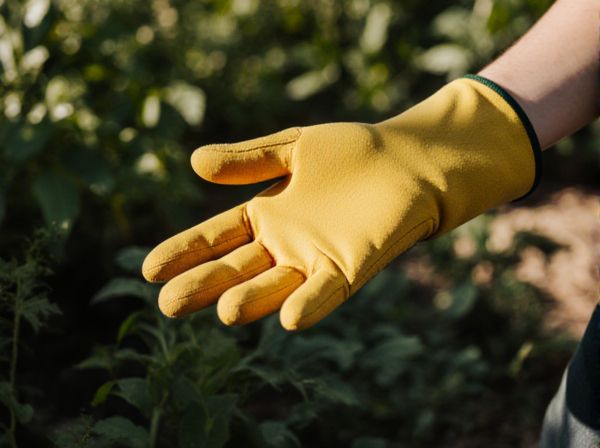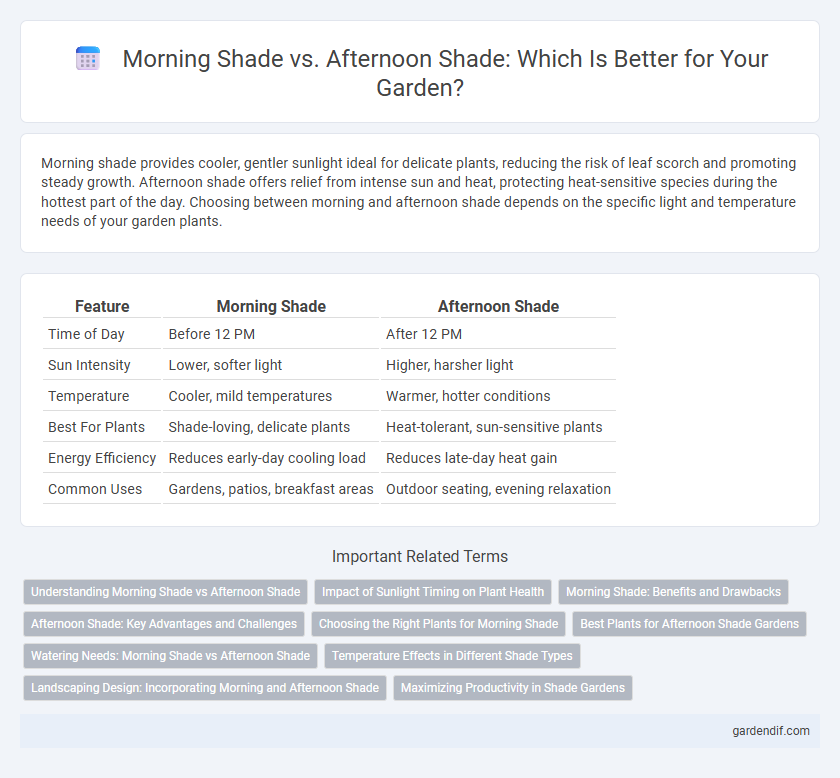
Morning Shade vs Afternoon Shade Illustration
Morning shade provides cooler, gentler sunlight ideal for delicate plants, reducing the risk of leaf scorch and promoting steady growth. Afternoon shade offers relief from intense sun and heat, protecting heat-sensitive species during the hottest part of the day. Choosing between morning and afternoon shade depends on the specific light and temperature needs of your garden plants.
Table of Comparison
| Feature | Morning Shade | Afternoon Shade |
|---|---|---|
| Time of Day | Before 12 PM | After 12 PM |
| Sun Intensity | Lower, softer light | Higher, harsher light |
| Temperature | Cooler, mild temperatures | Warmer, hotter conditions |
| Best For Plants | Shade-loving, delicate plants | Heat-tolerant, sun-sensitive plants |
| Energy Efficiency | Reduces early-day cooling load | Reduces late-day heat gain |
| Common Uses | Gardens, patios, breakfast areas | Outdoor seating, evening relaxation |
Understanding Morning Shade vs Afternoon Shade
Morning shade offers cooler temperatures and gentler light, which benefits shade-loving plants by reducing heat stress and preventing leaf scorch. Afternoon shade provides relief from intense, direct sunlight, often necessary in hot climates to protect sensitive foliage and maintain soil moisture. Understanding the differences helps gardeners select appropriate plants and optimize growth conditions based on local sun exposure patterns.
Impact of Sunlight Timing on Plant Health
Morning shade provides plants with protection from intense afternoon heat, reducing water loss and heat stress while still allowing beneficial early sunlight exposure for photosynthesis. Afternoon shade shields plants from the harshest midday sun rays, preventing leaf scorch and dehydration during peak temperature hours, which is crucial for heat-sensitive species. Understanding the specific sunlight tolerance of each plant helps in optimizing garden placement to enhance plant health and growth by aligning with the appropriate shade timing.
Morning Shade: Benefits and Drawbacks
Morning shade offers cooler temperatures and gentler sunlight, which reduces the risk of leaf scorch and promotes healthier plant growth during the early part of the day. This type of shading helps conserve soil moisture by minimizing evaporation compared to afternoon shade, which often brings intense heat stress and potential dehydration. However, morning shade may limit photosynthesis if plants require longer exposure to direct sunlight, potentially slowing growth for sun-loving species.
Afternoon Shade: Key Advantages and Challenges
Afternoon shade provides crucial relief from intense midday sun, reducing heat stress and preventing plant scorch during peak sunlight hours. This type of shade supports cooler microclimates, which enhance plant growth for heat-sensitive species by limiting excessive evaporation and water loss. Challenges include limited sunlight exposure, which can hinder photosynthesis in sun-loving plants, requiring careful selection of shade-tolerant varieties to thrive under afternoon shade conditions.
Choosing the Right Plants for Morning Shade
Morning shade provides cool, gentle sunlight for several hours, making it ideal for plants requiring partial sunlight without extreme heat stress. Plants such as ferns, hostas, astilbes, and impatiens thrive in morning shade because they benefit from filtered light and cooler temperatures. Selecting species that favor morning shade promotes healthy growth, vibrant foliage, and prolonged blooming periods in shaded garden areas.
Best Plants for Afternoon Shade Gardens
Afternoon shade gardens benefit most from plants that thrive in dappled light or partial sun, such as hostas, astilbes, and ferns, which tolerate the warmer, indirect afternoon rays. These plants exhibit strong growth and vibrant foliage under filtered sunlight, adapting to the heat stress typical of afternoon shade environments. Incorporating shade-loving perennials like heuchera and solomon's seal ensures year-round interest and resilience in garden areas with limited direct sun exposure after noon.
Watering Needs: Morning Shade vs Afternoon Shade
Plants in morning shade typically require less frequent watering because cooler temperatures reduce evaporation rates. Afternoon shade areas tend to be warmer and drier, increasing the plants' water needs to prevent stress and maintain healthy growth. Understanding these differences helps optimize irrigation schedules for shade-tolerant species like hostas, ferns, and impatiens.
Temperature Effects in Different Shade Types
Morning shade typically results in cooler temperatures due to lower solar intensity, which helps reduce heat stress on plants and outdoor environments. In contrast, afternoon shade tends to be warmer because surfaces absorb heat throughout the day, radiating it back even when shaded, influencing microclimates differently. Understanding these temperature variations is critical for optimizing plant growth, energy efficiency, and outdoor comfort in shaded areas.
Landscaping Design: Incorporating Morning and Afternoon Shade
In landscaping design, incorporating morning shade helps protect delicate plants from intense early sunlight, promoting healthier growth and vibrant foliage. Afternoon shade provides crucial relief during peak heat hours, reducing water evaporation and preventing soil dehydration. Strategically positioning trees and structures to balance morning and afternoon shade enhances plant resilience and overall garden sustainability.
Maximizing Productivity in Shade Gardens
Morning shade offers gentler light conditions that help prevent overheating and stress in shade-loving plants, thereby enhancing photosynthesis efficiency and growth. Afternoon shade provides protection from the intense midday sun, reducing water evaporation and preserving soil moisture crucial for maximizing productivity in shade gardens. Selecting plants adapted to specific shade patterns, such as ferns and hostas for morning shade or impatiens and begonias for afternoon shade, further optimizes garden yields.
Morning Shade vs Afternoon Shade Infographic

 gardendif.com
gardendif.com